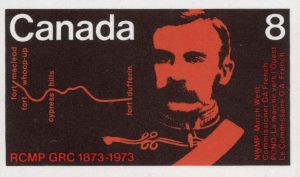On today’s date in 1873, the government of prime minister John A. Macdonald proposed an act to establish a mounted police force for the North-Western Territory (known today as the Northwest Territories).
Named for its location in relation to Rupert’s Land – the exclusive commercial domain of the Hudson’s Bay Company (HBC) from 1670-1870 – the North-Western Territory included present-day Yukon; the mainland Northwest Territories; northwestern mainland Nunavut; northwestern Saskatchewan; northern Alberta; and northern British Columbia. The vast region was controlled by the HBC until it ceded the land to the newly formed Dominion of Canada in 1870.
In 1867, Canada consisted of only four eastern provinces; however, three years later – on July 15, 1870 – the government acquired Rupert’s Land from the HBC.
Opening the region to settlement required peaceful relations with Indigenous populations as well as the suppression of the whisky trade, and army officials surveying the area recommended a force of up to 150 mounted riflemen to maintain law and order.
THE ACT PASSES
The act proposed by the Macdonald government eventually passed on May 23, 1873.
The prime minister unveiled the new force as the “North West Mounted Rifles,” but concerns about antagonizing both the U.S. population to the south and the Indigenous population at home spurred officials to use the name the North-West Mounted Police (NWMP).
It was a predecessor of today’s Royal Canadian Mounted Police (RCMP).
The general duties of the NWMP, according to Library and Archives Canada, included:
- establishing law and order;
- collecting customs dues;
- enforcing prohibition;
- supervising the treaties between First Nations and the federal government;
- assisting in the settlement process;
- ensuring the welfare of immigrants; and
- fighting prairie fires, disease and destitution.
NWMP, RCMP STAMPS
In 1935, Canada’s Post Office Department (now Canada Post) issued a 10-cent stamp depicting an RCMP officer on horseback.
The horse and landscape were engraved by Harold Osborn while the officer was engraved by Sydney F. Smith. The stamp itself was designed by Herman Herbert Schwartz.
In 1973, the Post Office Department issued another stamp, this with a face value of eight cents, featuring the NWMP’s “march west” and its commissioner G.A. French.
The NWMP was tasked with policing about 777,000 square kilometres of wilderness in the Canadian northwest in an attempt to suppress the whisky trade, calm the growing unrest among the Indigenous population and stamp out lawlessness throughout the vast territory.
“Fear of the Fenian raids from the south and the possibility of losing the West by default made it imperative that Canada quickly take official possession of the area. July 1874 saw three hundred raw recruits under G.A. French, the first commissioner, set out from Dufferin, Manitoba, across the plains to Old Man’s River in what is now southern Alberta. There they constructed Fort Macleod, named for the Assistant Commissioner,” reads a press release issued by the postal service in 1973.
“The rigorous trek … revealed in the men a stamina that augured will. Within a very few months the Indians came to sense the meaning of the scarlet tunic and the motto it represented: ‘Maintiens le Droit,’ ‘Uphold the Right.’”


